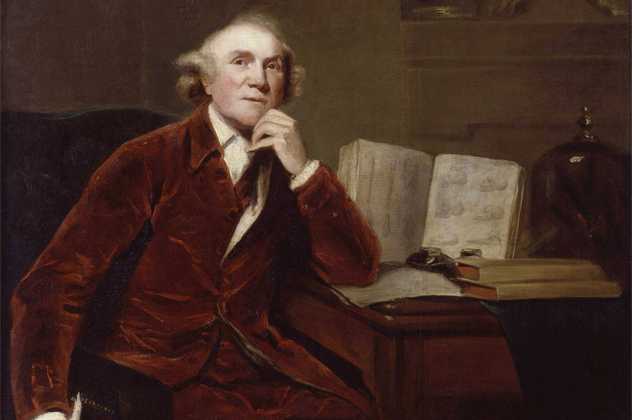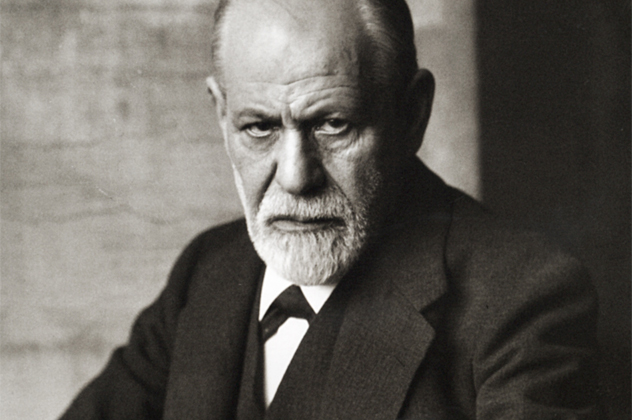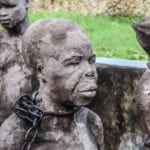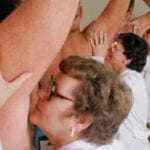 Movies and TV
Movies and TV  Movies and TV
Movies and TV  Creepy
Creepy 10 Eerie & Mysterious Ghosts of the Pacific Coast
 Weird Stuff
Weird Stuff 10 Typos That Accidentally Changed History
 History
History 10 Times Trickery Won Battles
 Technology
Technology 10 Awesome Upgrades to Common Household Items
 Misconceptions
Misconceptions 10 Hilarious (and Totally Wrong) Misconceptions About Childbirth
 Weird Stuff
Weird Stuff 10 Warning Labels That Exist Because Someone Actually Tried It
 Health
Health Ten Confounding New Inventions from the World of Biomedicine
 Creepy
Creepy 10 Death Superstitions That Will Give You the Creeps
 Movies and TV
Movies and TV 10 Movies That Get Elite Jobs Right, According to Experts
 Movies and TV
Movies and TV 10 Most Realistic Medical TV Shows of All Time
 Creepy
Creepy 10 Eerie & Mysterious Ghosts of the Pacific Coast
 Weird Stuff
Weird Stuff 10 Typos That Accidentally Changed History
Who's Behind Listverse?

Jamie Frater
Head Editor
Jamie founded Listverse due to an insatiable desire to share fascinating, obscure, and bizarre facts. He has been a guest speaker on numerous national radio and television stations and is a five time published author.
More About Us History
History 10 Times Trickery Won Battles
 Technology
Technology 10 Awesome Upgrades to Common Household Items
 Misconceptions
Misconceptions 10 Hilarious (and Totally Wrong) Misconceptions About Childbirth
 Weird Stuff
Weird Stuff 10 Warning Labels That Exist Because Someone Actually Tried It
 Health
Health Ten Confounding New Inventions from the World of Biomedicine
 Creepy
Creepy 10 Death Superstitions That Will Give You the Creeps
 Movies and TV
Movies and TV 10 Movies That Get Elite Jobs Right, According to Experts
10 Scientists Who Completely Ignored The Idea Of Human Rights
There’s always a cost to progress, but there are times when scientists take it a step too far. Ignoring basic human rights in order to perform valuable research is still ignoring basic human rights, and the cost of lives can be staggering. Sadly, it’s all too often that it’s the researcher and his work that’s remembered, and not the people who were killed, traumatized, and dosed with radiation in order for one man (or woman) to climb to the top of the pile.
10 Saul Krugman

In 1954, Dr. Saul Krugman began work at New York’s Willowbrook State School on Staten Island, a facility that housed mentally disabled children. Krugman, an infectious disease consultant, wanted to study the spread and development of hepatitis through a controlled population, as well as to test possible vaccines. To do this, he used a subject pool of 700 children. Half he injected with a mild form of the hepatitis virus to see if their bodies would successfully fight off the disease and if they would retain immunity to it. The other half was just the control group.
In the end, they concluded that those children whom they had infected with hepatitis had milder symptoms than those who simply got it on their own. As justification for their experiment, Krugman and his staff pointed to the rampant cases of hepatitis already in the population, and cited that there was no undue risk—they were simply giving the children something they were bound to get anyway. Critics state that not only is it not acceptable to infect anyone with such a disease in the first place, but also that the study was largely dishonest with the parents of children they infected. They did ask for consent, but didn’t disclose the risks.
They were also accused of telling parents that there was no room left in the non-experimental sections of the school, and that in order to enroll their children they also needed to enroll them in the hepatitis study. Critics also point out that time would have been better spent cleaning up the situation that was causing hepatitis in the first place, rather than just making it worse.
9 Laud Humphreys

Laud Humphreys was a 1960s sociologist who was extremely interested in what went on in men’s public bathrooms—specifically, homosexual encounters that were often impersonal displays of affection that got a lot of people arrested in the 60s and 70s. He wanted to know what motivated the men to participate in what was called “Tearoom Sex,” as well as just who these men were and what their lives were outside of bathroom fellatio.
So he established himself in the community not as a participant, but as a “watchqueen;” that is, a person who would remain in the room and watch out for authorities. As such, he befriended many of the men he protected, and convinced many of them to share personal details about themselves with him—all without revealing who he was and what he was really doing.
Humphreys went a step further with those that had no interest in revealing more about themselves. He would follow them when they left the bathroom, recording license plate numbers and addresses. Later, he would return to the houses in a disguise and pretend to be a health service interviewer to get the answers to questions they’d previously refused to answer. While there were benefits to his research in the end—like the end of the criminality of these acts—it also caused massive public outrage and introduced questions on the violation of privacy and the making public of private information.
8 John Hunter

Born in Scotland in the 18th century, John Hunter is still known as one of the founders of modern surgical techniques. While his contributions to science are clear, his methods were less than honorable. After abandoning formal education when he was 13, Hunter spent seven years roaming the countryside and dissecting animals. When he was 20, he moved to London with his brother, William, who was already the head of a medical school. William gave his younger brother a position in the school, and John was responsible for ensuring that there was a constant supply of dead bodies for anatomy and dissection exercises.
It’s thought that he started by going out into the graveyards himself to dig up freshly buried bodies, but soon found an easier way to procure the corpses. His association with body-snatchers and grave robbers was a well documented relationship that would last his entire life. And when they couldn’t get him what he wanted, he wasn’t always above just taking it. Teeth for his experimental process of grafting one person’s teeth in another’s mouth were graciously “donated.”
Composer Joseph Haydn was a good friend of Hunter’s wife, and also a sufferer of nasal polyps. When Haydn refused Hunter’s offer to remove them, Hunter sent him a message inviting him to his home; upon entering, Haydn was manhandled into an operating chair by two hired goons, and only barely managed to talk his way out of the operation. In the end, Hunter died in 1793 and was systematically dissected by his students.
7 Ewen Cameron

Dr. Ewen Cameron is most well-known for his work with the CIA and the brain-altering project MKUltra. But even without the help of the government, he had already established a pattern of ignoring basic human rights and conducting his experiments with his own questionable twist. Long interested in memory and how it functions, he developed a process that he called depatterning and psychic driving. The goal of the treatment was to destroy a person’s memory and personality, so it could then be replaced by another.
One patient, only identified as Mary C, was subjected to 35 days of sensory deprivation followed by 101 days of psychic driving—the endless repeating of a recording of positive messages. Other patients were subjected to controlled comas, and up to 85 days of listening to a looped recording while drifting in and out of consciousness. The part of his research where he wanted to destroy a person’s mind worked—but he never successfully rebuilt one.
Contemporaries scoffed at his dangerous work, but he was able to continue because of his position with various governments. It was Cameron who examined Nazi war criminal Rudolph Hess to see if he was capable of standing trial, though some sources suggest he was under the belief that the real Hess had already been executed, and he was interviewing a fake.
6 Cornell University’s Practice Babies

If your last name is Domecon, you should probably look into that. That’s because it’s the surname given to an undocumented number of orphan babies starting in 1919, and it means “domestic economy.” In what’s probably one of the most bizarre college classes ever, colleges like the University of Minnesota and Cornell University gave female students a great way to learn how to take care of a child—by practicing on a real baby. Those real babies were orphans, on loan to the university students.
All were between three months and a few years old, and lived in “practice apartments” which served as a sort of classroom for young women to learn all the skills necessary to run a household and raise a child. Babies would have constant care, and some also had as many as 11 or 12 different mothers during their time in university care. Each student would spend six weeks living in the apartment and raising their practice baby, then turn the whole thing over to the next girl. Some of the babies raised in the program, which was ended in Cornell in 1969, have come forward and, tragically, their early, unstable upbringing has left many with lifelong trust issues and other mental health concerns.
5 Freud And Emma Eckstein

Sigmund Freud has been the target of a lot of criticism over the years, and his treatment and diagnosis of Emma Eckstein falls straight into the bizarre category. Eckstein was a patient of Freud’s, and while her exact complaint isn’t documented, papers hint to the fact that it was problems with an irregular and painful menstruation. Because Freud believed that there was an inarguable relationship between the nose and the genitals, his solution to her problem was, of course, to remove part of her nose.
Not only did it not work, but her nose refused to heal. Massive hemorrhaging resulted, and Freud realized that the doctor who had performed the surgery had left gauze packed into her nose that kept the wound from healing. Once her nose healed (a year later), her original complaint was still uncured. Freud came to the only conclusion he could: It wasn’t his theory that was flawed, of course, and it certainly wasn’t the doctor . . . it was Eckstein that was causing her own problems by her uncontrollable lust and longing for him.
In defense of the doctor who had performed and botched the surgery (who was also a good friend of Freud’s), he concluded that not only were her original problems not cured because of this insatiable longing, but that the doctor hadn’t been at fault in the first place, and her massive hemorrhaging from her mangled nose had also simply been a manifestation of her desire for Freud himself.
4 Muzafer Sherif

Muzafer Sherif was a psychologist practicing in the 1950s. He was interested in the development and stages of conflict that would escalate between two groups of individuals. So, what better way to get a first-hand experience with such a potentially violent situation than to take two groups of 11-year-old boys on a camping trip, and pit them against each other to see how far the conflict would go?
The 22 pre-adolescents didn’t know that their camping trip to Robbers Cave State Park in Oklahoma was actually a psychological experiment, but it didn’t take long for the group to descend from being boys on a camping holiday to a downright hate-fest. Divided into two groups, the Rattlers and the Eagles, the boys were first only exposed to—and allowed to bond with—members of their own group. Once relationships were cemented, they were introduced to the other group and pitted against each other in competitions. What started out with a little name-calling soon turned into a refusal to associate with the other group, destruction of property, food fights, and even complaints when the two groups had to share pencils.
Once the two groups hated each other sufficiently, researchers introduced tasks and problems which required them to work together. This slowly resulted in a decrease in hostilities between the two groups, during which time the boys would work together. At the end of the experiment, the boys were left with lasting distaste toward each other.
3 Chester Southam

In the 1960s, Dr. Chester Southam started his cancer research by injecting live cancer cells into volunteers at the Ohio State Penitentiary. Upon discovering that the immune systems of healthy individuals would reject the cancer cells within a month or so, he also found that those who were already fighting cancer would have a much slower immune response to newly introduced cells. So Southam decided to broaden his subject base, and began injecting cancer cells into cancer-free, elderly patients at the Jewish Chronic Disease Hospital in Brooklyn.
After convincing hospital directors that he wasn’t doing anything that needed consent forms, or that he even needed to tell patients what they were being injected with, Southam proceeded to inject 22 chronically ill patients with cancer cells. It was kept so quiet that the hospital’s chief of medicine didn’t even know what was going on—until the injections were completed. Ironically, three doctors at the hospital—who had originally been approached by Southam and had turned had him down—were Holocaust survivors and had lost family members in Nazi Germany.
2 Eugene Saenger

Depending on what you’re reading, Dr. Eugene Saenger is either a hero or a monster. The University of Cincinnati even has a scholarship fund in his name, calling him “a pioneer in Nuclear Medicine.” But what they don’t mention is that his methods of research were more than a little questionable. In the 1960s, Saenger exposed more than 90 cancer patients to massive doses of radiation under the guise of exploring a potential cure and attempting to relieve their symptoms.
But what was really going on was a study sponsored and requested by the Pentagon, done with the goal of finding out how much radiation a person could be exposed to before they became disabled or disoriented beyond functionality. The subjects were poor and working-class individuals, and about 60 percent of them were black. Twenty-one of the patients exposed to radiation died within a month of first exposure, although Saenger has alternately said that only eight deaths were due to radiation exposure, later recanting and saying that none were.
While Saenger had long claimed that he told patients that they were going to be exposed to radiation, and even collected consent forms years before it was a requirement, critics say that what he neglected to tell those he was experimenting on was that they could die from the radiation.
1 Lauretta Bender

Lauretta Bender was a neuropsychiatrist at Bellevue Hospital in the 1940s and early 1950s. She pioneered research into using electroshock therapy on children, especially those who had been diagnosed as autistic. Called vain, proud, and unreceptive to even the most obvious criticism, Bender publicly flaunted her successes in treating children as young as four with electroshock therapy. Behind the closed doors of Bellevue, though, children subjected to her methods regressed into violence or catatonic states. In adulthood, many of her patients have been in and out of jail, committed suicide, or returned to parents who have called them “ruined.”
Children who endured her treatment and wrote about it later described the horrible conditions not only during treatment, but in Bellevue, where they were even forced to sing and act happy in the face of brutality. Children were shocked until they had seizures or blacked out, and then were given candy when they awoke. Some have come forward with diagnoses of just being shy or withdrawn as children; many of those that Bender subjected to electroshock therapy were incorrectly diagnosed as autistic or schizophrenic. Bender later expanded her treatments to include LSD.








